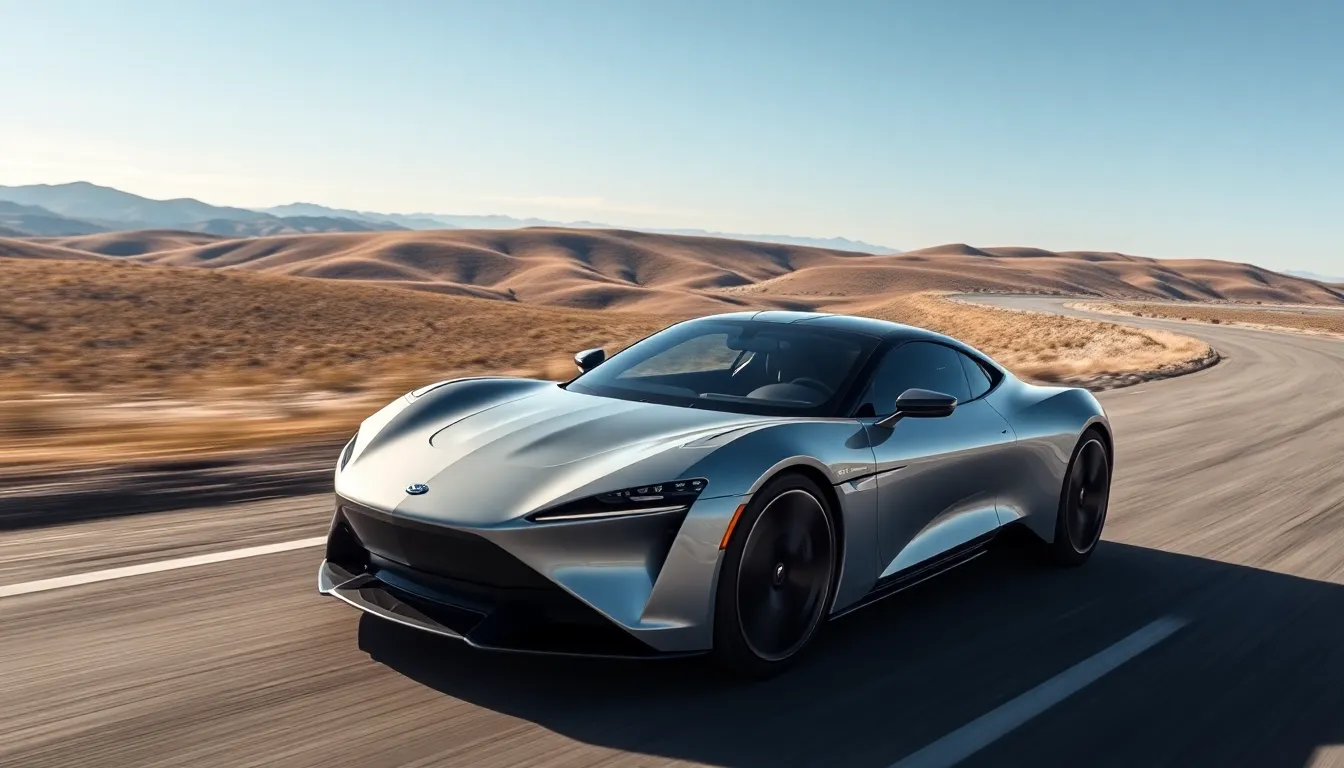Picture this: you’re cruising down the highway in your shiny new electric vehicle, feeling like a futuristic superhero. Suddenly, that dreaded warning light pops up, and your heart races faster than your car. Welcome to the world of range anxiety, where the only thing more terrifying than running out of battery is being stranded in the middle of nowhere, with only a tumbleweed for company.
Table of Contents
ToggleUnderstanding Range Anxiety
Range anxiety represents a significant concern for electric vehicle owners. This issue centers on the fear of depleting battery power while driving.
Definition of Range Anxiety
Range anxiety refers to the worry that an electric vehicle won’t reach its destination due to insufficient battery charge. It encompasses feelings of stress when distances between charging stations exceed an EV’s available range. This anxiety can affect decision-making, leading to route alterations and increased planning efforts. As battery technology improves, some believe this concern may lessen, yet it remains a barrier for many potential EV users today.
Factors Contributing to Range Anxiety
Several factors influence the prevalence of range anxiety among electric vehicle operators. The availability of charging stations can significantly impact drivers’ confidence in their EV’s performance. Individuals with less experience in managing battery levels may face heightened fear during longer trips. Actual range limitations of specific electric vehicle models also play a crucial role. Additionally, driving conditions such as elevation and temperature can affect battery performance, leading to increased concern among drivers.
Impact of Range Anxiety on Electric Vehicle Adoption
Range anxiety significantly influences electric vehicle adoption rates. It shapes consumer decisions and can deter potential buyers from choosing EVs.
Consumer Behavior and Perceptions
Consumer behavior is heavily impacted by range anxiety. Many prospective EV owners express concerns over battery limitations. Surveys indicate that about 60% of individuals cite range as a primary barrier to electric vehicle adoption. Perceptions often exaggerate the limitations of current EV technology. Drivers frequently underestimate the range of newer models equipped with advanced battery systems. Concerns about charging infrastructure also contribute to reluctance. Many consumers hesitate to trust the availability of charging stations, especially in rural areas. Some potential buyers prioritize vehicles with longer ranges, further skewing market dynamics.
Case Studies and Statistics
Case studies reveal the extent of range anxiety’s impact. A study by the California Air Resources Board showed that the adoption of electric vehicles increased by 30% after public charging stations were installed in several communities. Statistical data underscores the connection between charging infrastructure and consumer confidence. In regions where charging stations are plentiful, range anxiety decreases, resulting in higher EV registration rates. Approximately 80% of drivers reported feeling more secure knowing charging stations are within a reasonable distance from their routes. Data from the National Renewable Energy Laboratory confirms that improved charging options directly correlate with a rise in electric vehicle sales across various markets.
Solutions to Mitigate Range Anxiety
Advancements in battery technology and the expansion of charging infrastructure play critical roles in reducing range anxiety for electric vehicle drivers.
Advancements in Battery Technology
New battery technologies are enhancing electric vehicles’ range capabilities. Solid-state batteries, for instance, provide higher energy densities than traditional lithium-ion options. Manufacturers are investing in research to improve battery efficiency, leading to longer driving distances. Additionally, fast-charging technologies reduce the time spent at charging stations, further alleviating concerns. Some models now achieve ranges exceeding 300 miles on a single charge. These advancements in battery technology not only improve performance but also enhance driver confidence when choosing electric vehicles over internal combustion engines.
Expansion of Charging Infrastructure
The expansion of charging infrastructure directly impacts a driver’s comfort level while operating an electric vehicle. Governments and private companies are increasing investments in charging stations across urban and rural areas. Statistics reveal that regions with a dense network of charging stations enjoy a 30% rise in electric vehicle adoption. Public charging options are becoming more accessible, creating a more supportive environment for EV owners. Besides, partnerships with convenience stores and restaurants for charging stations make recharging simpler during everyday stops. Enhanced accessibility to charging stations leads to a more favorable perspective on electric vehicle ownership, significantly mitigating range anxiety.
The Role of Education and Awareness
Education and awareness play significant roles in addressing range anxiety among electric vehicle owners. Providing accurate information about battery capacities can empower consumers and enhance their confidence in EV technology.
Informing Consumers about Range Capacities
Educating consumers about the actual range of electric vehicles proves essential in alleviating concerns. Breakdown of battery capacities across various EV models helps consumers understand their options better. Sharing data shows that numerous current models achieve over 200 miles on a single charge, which exceeds the daily commuting needs of many drivers. Studies confirm that informed drivers feel more secure knowing their vehicle can meet their travel requirements. Access to this information encourages a more realistic perspective toward electric vehicle ownership.
Promoting Efficient Driving Practices
Teaching efficient driving practices contributes greatly to reducing range anxiety. Emphasizing smooth acceleration and maintaining a steady speed can significantly extend battery life. Implementing regenerative braking techniques, which capture energy during slowing, enhances battery efficiency as well. Statistics indicate that drivers using these methods can experience up to 15% increased range. Encouragement to adopt these practices not only mitigates anxiety but also optimizes the overall driving experience for electric vehicle owners.
Future Perspectives on Range Anxiety
Current trends indicate potential solutions to range anxiety. Innovations in electric vehicles and charging infrastructure may help reshape consumer perspectives.
Innovations on the Horizon
Recent advancements hint at a brighter future for electric vehicle technology. Solid-state batteries promise higher energy densities, enabling ranges over 300 miles per charge. Fast-charging techniques reduce wait times, improving user experiences significantly. Manufacturers are focusing on integrating more efficient battery management systems, which can extend the range of existing models. Furthermore, new partnerships between automakers and charging networks are increasing the number of accessible charging stations, particularly in underserved areas. Data demonstrates that enhanced charging options can lead to a 30 percent spike in electric vehicle adoption. Such innovations directly address the concerns driving range anxiety among consumers.
Shifts in Consumer Attitudes
Shifts in consumer attitudes reveal increasing acceptance of electric vehicles. Recent surveys suggest that around 60 percent of individuals still view range as a primary barrier to EV adoption. However, awareness campaigns have started altering these perceptions, showing that many models exceed 200 miles per charge. Confident statements from drivers who’ve had positive experiences with their EVs further contribute to changing views. Education about actual range capabilities seems essential in fostering trust. Reports indicate that informed consumers feel less anxious about battery life, often considering range limitations less daunting. Such changes in perspectives may bolster electric vehicle sales in the near future.
Range anxiety continues to be a significant hurdle for electric vehicle adoption. As technology advances and charging infrastructure expands, the potential for alleviating these concerns grows. Educating consumers about the actual capabilities of modern EVs can reshape perceptions and increase confidence in their choices.
With innovations like solid-state batteries and fast-charging solutions on the horizon, the future looks promising. As more charging stations become available and drivers become better informed, range anxiety may diminish, paving the way for a more widespread acceptance of electric vehicles. The journey toward a sustainable automotive future relies on overcoming these psychological barriers and enhancing the overall EV experience.





